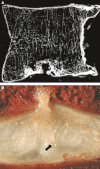Intervertebral disc degeneration: evidence for two distinct phenotypes
- PMID: 22881295
- PMCID: PMC3512277
- DOI: 10.1111/j.1469-7580.2012.01551.x
Intervertebral disc degeneration: evidence for two distinct phenotypes
Abstract
We review the evidence that there are two types of disc degeneration. 'Endplate-driven' disc degeneration involves endplate defects and inwards collapse of the annulus, has a high heritability, mostly affects discs in the upper lumbar and thoracic spine, often starts to develop before age 30 years, usually leads to moderate back pain, and is associated with compressive injuries such as a fall on the buttocks. 'Annulus-driven' disc degeneration involves a radial fissure and/or a disc prolapse, has a low heritability, mostly affects discs in the lower lumbar spine, develops progressively after age 30 years, usually leads to severe back pain and sciatica, and is associated with repetitive bending and lifting. The structural defects which initiate the two processes both act to decompress the disc nucleus, making it less likely that the other defect could occur subsequently, and in this sense the two disc degeneration phenotypes can be viewed as distinct.
© 2012 The Authors. Journal of Anatomy © 2012 Anatomical Society.
Figures





References
-
- Adams MA, Dolan P. A technique for quantifying the bending moment acting on the lumbar spine in vivo. J Biomech. 1991;24:117–126. - PubMed
-
- Adams MA, Hutton WC. Prolapsed intervertebral disc. A hyperflexion injury 1981 Volvo award in basic science. Spine. 1982;7:184–191. - PubMed
-
- Adams MA, Hutton WC. Gradual disc prolapse. Spine. 1985;10:524–531. - PubMed
-
- Adams MA, Roughley PJ. What is intervertebral disc degeneration, and what causes it? Spine. 2006;31:2151–2161. - PubMed
-
- Adams MA, Dolan P, Hutton WC. Diurnal variations in the stresses on the lumbar spine. Spine. 1987;12:130–137. - PubMed
Publication types
MeSH terms
LinkOut - more resources
Full Text Sources
Medical

